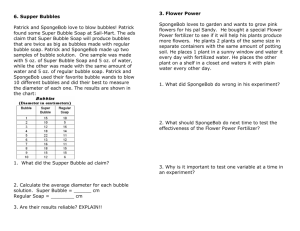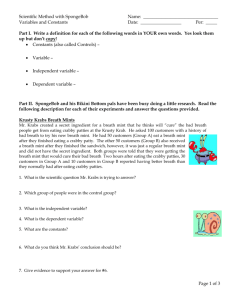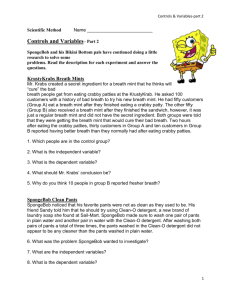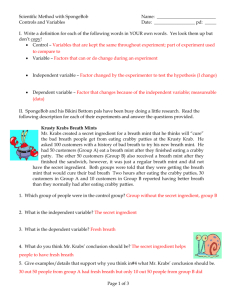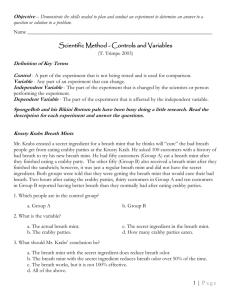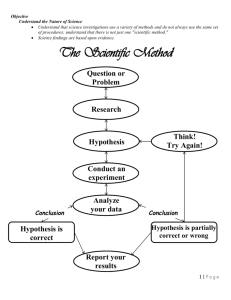Evolution of an Atom Book Assignment
advertisement
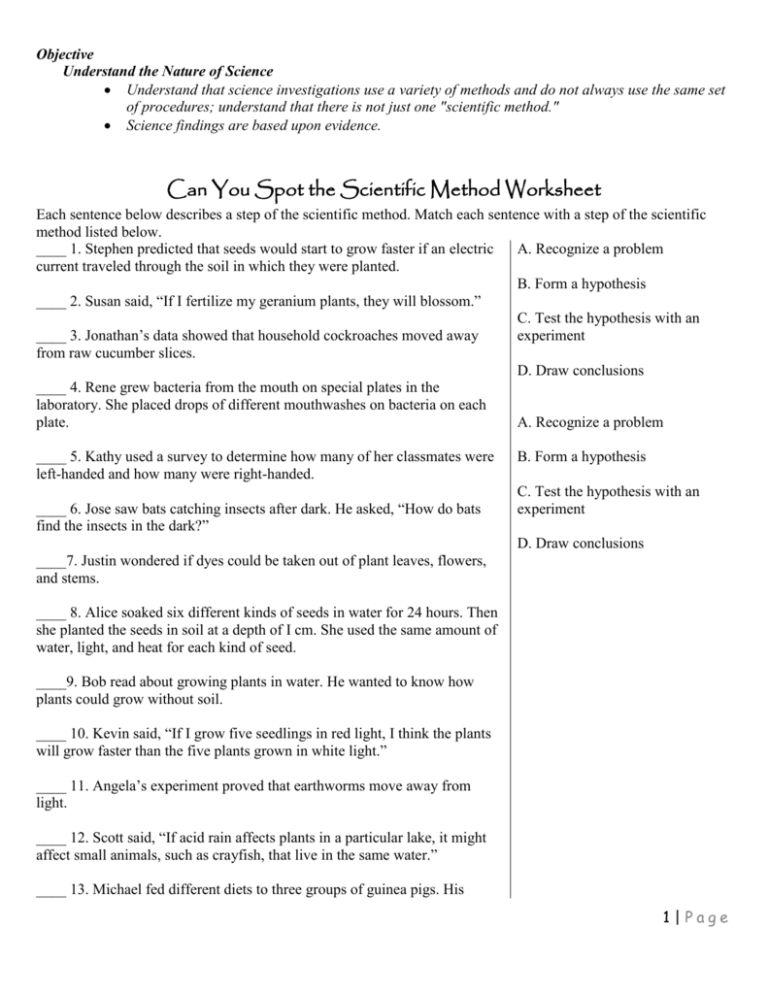
Objective Understand the Nature of Science Understand that science investigations use a variety of methods and do not always use the same set of procedures; understand that there is not just one "scientific method." Science findings are based upon evidence. Can You Spot the Scientific Method Worksheet Each sentence below describes a step of the scientific method. Match each sentence with a step of the scientific method listed below. ____ 1. Stephen predicted that seeds would start to grow faster if an electric A. Recognize a problem current traveled through the soil in which they were planted. B. Form a hypothesis ____ 2. Susan said, “If I fertilize my geranium plants, they will blossom.” C. Test the hypothesis with an ____ 3. Jonathan’s data showed that household cockroaches moved away experiment from raw cucumber slices. D. Draw conclusions ____ 4. Rene grew bacteria from the mouth on special plates in the laboratory. She placed drops of different mouthwashes on bacteria on each plate. A. Recognize a problem ____ 5. Kathy used a survey to determine how many of her classmates were left-handed and how many were right-handed. ____ 6. Jose saw bats catching insects after dark. He asked, “How do bats find the insects in the dark?” B. Form a hypothesis C. Test the hypothesis with an experiment D. Draw conclusions ____7. Justin wondered if dyes could be taken out of plant leaves, flowers, and stems. ____ 8. Alice soaked six different kinds of seeds in water for 24 hours. Then she planted the seeds in soil at a depth of I cm. She used the same amount of water, light, and heat for each kind of seed. ____9. Bob read about growing plants in water. He wanted to know how plants could grow without soil. ____ 10. Kevin said, “If I grow five seedlings in red light, I think the plants will grow faster than the five plants grown in white light.” ____ 11. Angela’s experiment proved that earthworms move away from light. ____ 12. Scott said, “If acid rain affects plants in a particular lake, it might affect small animals, such as crayfish, that live in the same water.” ____ 13. Michael fed different diets to three groups of guinea pigs. His 1|Page Objective Understand the Nature of Science Understand that science investigations use a variety of methods and do not always use the same set of procedures; understand that there is not just one "scientific method." Science findings are based upon evidence. experiment showed that guinea pigs need vitamin C and protein in their diets. Dinosaur Scene - Observation and Inference Worksheet Suppose you are a paleontologist and you have just discovered a layer of rock with many fossils in it, both petrified bones and tracks. Decide whether the following statements are observations or inferences. 19. _____ There are tracks from three different animals in the rock. A. Observation 20. _____ One animal was chasing another animal. B. Inference 21 _____. Two different animals died in this spot. 22. _____ When the animals walked here the ground was wet. 23. _____ One of the animals that died here had bony plates. 24. _____ One of the animals that died here had sharp teeth. 25. _____ The animal that had sharp teeth ate meat. 2|Page Objective Understand the Nature of Science Understand that science investigations use a variety of methods and do not always use the same set of procedures; understand that there is not just one "scientific method." Science findings are based upon evidence. Qualitative Observations vs. Quantitative Observations Worksheet All of the observations in this worksheet were qualitative; that is, you observed a quality about an object (it smelled good, it was green, etc.). Another type of observation is quantitative, meaning that it can be described or measured in concrete numerical terms. The following observations are quantitative: There are 30 students in my class. I weigh 98 pounds. I ate a pound of potatoes. Determine which of the following statements are quantitative and which are qualitative. _____1. The cup had a mass of 454 grams. A. Qualitative _____2. The temperature outside is 250o C. B. Quantitative _____3. It is warm outside. _____4. The tree is 30 feet tall. _____5. The building has 25 stories. _____6. The building is taller than the tree. _____7. The sidewalk is long. _____8. The sidewalk is 100 meters long. _____9. The race was over quickly. _____10. The race was over in 10 minutes. 3|Page Objective Understand the Nature of Science Understand that science investigations use a variety of methods and do not always use the same set of procedures; understand that there is not just one "scientific method." Science findings are based upon evidence. Scientific Method - Controls and Variables SpongeBob and his Bikini Bottom pals have been busy doing a little research. Read the description for each experiment and answer the questions. Krusty Krabs Breath Mints Mr. Krabs created a secret ingredient for a breath mint that he thinks will “cure” the bad breath people get from eating crabby patties at the Krusty Krab. He asked 100 customers with a history of bad breath to try his new breath mint. He had fifty customers (Group A) eat a breath mint after they finished eating a crabby patty. The other fifty (Group B) also received a breath mint after they finished the sandwich; however, it was just a regular breath mint and did not have the secret ingredient. Both groups were told that they were getting the breath mint that would cure their bad breath. Two hours after eating the crabby patties, thirty customers in Group A and ten customers in Group B reported having better breath than they normally had after eating crabby patties. 1. Which people are in the control group? a. Group A b. Group B 2. What is the variable? a. The actual breath mint. b. The secret ingredient in the breath mint. c. The crabby patties. d. How many crabby patties eaten. 3. What should Mr. Krabs’ conclusion be? a. The breath mint with the secret ingredient does reduce breath odor. b. The breath mint with the secret ingredient reduces breath odor over 50% of the time. c. The breath works, but it is not 100% effective. d. All of the above. SpongeBob Clean Pants SpongeBob noticed that his favorite pants were not as clean as they used to be. His friend Sandy told him that he should try using Clean-O detergent, a new laundry soap she found at Sail-Mart. SpongeBob made sure to wash one pair of pants in plain water and another pair in water with the Clean-O detergent. After washing both pairs of pants a total of three times, the pants washed in the Clean-O detergent did not appear to be any cleaner than the pants washed in plain water. 4. What was the problem SpongeBob wanted to investigate? a. Is Clean-O detergent effective? b. Is the length of time the pants are washed important? c. How does water temperature affect cleaning pants? d. Does how often I wash my pants affect how clean they are? 5. What is the variable? a. Water temperature. c. Laundry soap b. Length of wash time. d. Size of washing tub. 6. What should Sponge Bob’s conclusion be? a. Clean-O best cleans his pants. b. Plain water best cleans his pants. c. Cold water best cleans his pants. d. Clean-O is not effective cleaning his pants. 4|Page Objective Understand the Nature of Science Understand that science investigations use a variety of methods and do not always use the same set of procedures; understand that there is not just one "scientific method." Science findings are based upon evidence. Super Bubbles Patrick and SpongeBob love to blow bubbles! Patrick found some Super Bubble Soap at Sail-Mart. The ads claim that Super Bubble Soap will produce bubbles that are twice as big as bubbles made with regular bubble soap. Patrick and SpongeBob made up two samples of bubble solution. One sample was made with 5 oz. of Super Bubble Soap and 5 oz. of water, while the other was made with the same amount of water and 5 oz. of regular bubble soap. Patrick and SpongeBob used their favorite bubble wands to blow 10 different bubbles and did their best to measure the diameter of each one. The results are shown in the chart Bubbles (Diameter in centimeters) Bubble Super Bubble Regular Soap 1 2 3 4 5 6 15 10 12 18 22 13 10 5 16 14 11 12 7 16 11 8 9 10 18 15 12 15 15 6 9. What did the Super Bubble ads claim? a. Super Bubble produces bubbles twice as large as regular bubble soap. b. Super Bubble makes twice as many bubbles as regular bubble soap. c. Super Bubble bubbles last twice as long as bubbles made using regular bubble soap. d. Super Bubble is cheaper than regular bubble soap. 10. What is the variable? a. Bubble size. b. Number of bubbles made. c. Length of time bubbles last. d. Type of bubble solution. 11. What should their conclusion be? a. Super Bubble solution did not produce bubbles twice as large as those made with regular bubble soap. b. Regular bubble soap lasts twice as long as Super Bubble. c. Bubbles made with Super Bubble last twice as long as bubbles made with regular bubble soap. d. There was no difference between Super Bubble and regular bubble soap. 5|Page Objective Understand the Nature of Science Understand that science investigations use a variety of methods and do not always use the same set of procedures; understand that there is not just one "scientific method." Science findings are based upon evidence. Squidward’s Symphony Squidward loves playing his clarinet and believes it attracts more jellyfish than any other instrument he has played. In order to test his hypothesis, Squidward played a song on his clarinet for a total of 5 minutes and counted the number of jellyfish he saw in his front yard. He played the song a total of three times on his clarinet and repeated the experiment using a flute and a guitar. He also recorded the number of jellyfish he observed when he was not playing an instrument. The results are shown in the chart. Number of Jellyfish/Instrument Trial No Music Clarinet Flute Guitar 1 5 15 5 12 2 3 10 8 18 3 2 12 9 7 7. What is the variable? a. Number of jellyfish. b. Instrument. c. Length the music was played. d. The song he played. 8. What should Squidward’s conclusion be? a. The clarinet and guitar attracted the same number of jellyfish. b. The flute attracted more fish than the control (no music). c. Music attracts more jellyfish than does no music. d. All of the above. Slimotosis Sponge Bob notices that his pal Gary is suffering from slimotosis, which occurs when the shell develops a nasty slime and gives off a horrible odor. His friend Patrick tells him that rubbing seaweed on the shell is the perfect cure, while Sandy says that drinking Dr. Kelp will be a better cure. Sponge Bob decides to test this cure by rubbing Gary with seaweed for 1 week and having him drink Dr. Kelp. After a week of treatment, the slime is gone and Gary’s shell smells better. 12. What was the initial observation? a. Gary’s shell is dull in color and hard to see. 14. What should Sponge Bob’s conclusion be? b. Gary’s shell is glowing in the dark. a. Rubbing seaweed cured the slimotosis. c. Gary’s shell has a nasty slime and gives off b. Drinking Dr. Kelp cured the slimotosis. a horrible odor. c. Both rubbing seaweed and drinking Dr. d. Gary’s shell is developing holes in it. Kelp cured the slimotosis. 13. What is the variable? a. Rubbing seaweed on the shell. b. Drinking Dr. Kelp. c. Both a and b. d. We cannot determine which cured the slimotosis. The experiment must be redone, testing one variable at a time. 6|Page

